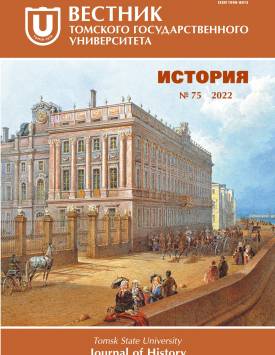Cultural and chronological position of the settlement of Shelomok III based on the materials of the 2017 excavations
The settlement of Shelomok III is located in the Tomsk Ob region, which in turn is the northernmost part of the vast Upper Ob region. The monument was opened in 1975 by L.M. Pletneva. At the same time, as well as in 1976, archaeological excavations were conducted, which established its cultural and chronological affiliation. In 2017 the author carried out excavation work at the settlement related to kulay culture and dated III-IV centuries BC and studied a part of the monument. The object, which presumably can be associated with the site for the production of ceramic vessels, was examined. Apparently, this is where the clay for the vessels was extracted, molded and burned. As a result of the excavations, a collection of finds was obtained, including 477 items, most of which are fragments of ceramic vessels. The purpose of the article is to clarify the cultural and chronological position of the settlement of Shelomok III, taking into account the data available to date the objects related to the kulay cultural and historical community. Special attention is paid to ceramics as the most sensitive cultural and chronological marker. The statistical analysis showed that the ceramic complex of the monument includes fragments from 27 vessels. According to the classification of ceramics of the Tomsk’s variant of kulay cultural-historical community, previously proposed by the author, 12 vessels belong to the group 1, 13 of the vessels to the group 4, 1 vessel to the group 6 and 1 vessel is in a mixed group, which can be attributed both to the group 4 and the group 7. The morphology of their upper parts is dominated by its open banks and poorly profiled pots (74 %), as well as closed banks (26%). Most of the vessels were round-bottomed. When decorating the vessels, 7 elements of the ornament were used, made in the technique of stamping. The most commonly used elements were in the form of pits, combs, and a duck stamp (smooth and combed). The elements of the ornament form 14 ornamental motifs. All of them have a horizontal arrangement. The motifs of the ornament form 9 ornamental compositions. Quantitatively, compositions made with the help of 3 elements of ornament with the use of 2 motifs predominate. The discovered metal products are made of iron, which indicates its widespread use. Stone tools are standard for early iron age settlements and include abrasives, percussion instruments, pestles for grinding, and anvils made from large rolled river boulders. The almost complete absence of ceramics with figurative and stamped ornamentation (except for the duck stamp) in the materials of the settlement of Shelomok III marks the upper timeframe of its existence which is no later than the first third of the III century AD. The lower border, for a number of signs, cannot be dated earlier than the end of the II - beginning of the III century AD. The archaeological research data allow to state that the settlement of Shelomok III reflects the final stage of the residence of Tomsk local variant kulay cultural-historical community population, formed earlier by interaction with the outside kulay and local shelomok cultures, on the eve of migration of fominsk culture to the territory of the Tomsk Ob region from the southern areas.
Keywords
pottery, the Tomsk Ob region, the early iron age, the local option kulay cultural-historical community of Tomsk, the settlement Shelomok III, archaeological digs, cultural and chronological affiliationAuthors
| Name | Organization | |
| Rybakov Dmitriy Yu. | Tomsk State University | dima0183@yandex.ru |
References

Cultural and chronological position of the settlement of Shelomok III based on the materials of the 2017 excavations | Tomsk State University Journal of History. 2022. № 75. DOI: 10.17223/19988613/75/22
